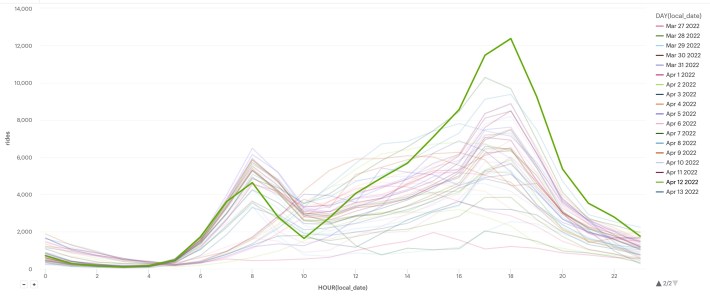It's times like these when you really see why Citi Bike is so important — and so fragile.
Commuters trying to avoid the subway on Tuesday after the subway mass shooting and again on Wednesday — or work-bound people just looking to enjoy the nice weather — took tens of thousands more rides than normal, but also faced a shortage of Citi Bike e-bikes that lasted through Wednesday afternoon.
The Lyft-owned company chalked it up to a perfect storm of transit troubles, nice weather and a shortage of staff.
The number of available pedal-assist bikes is usually 2,300 to 2,500 at any given time. But that number dropped to under 2,000 between 1:16 p.m. and 1:31 p.m. on Tuesday according to the automated CitiBike Stats Twitter account (which is not associated with Lyft or Citi Bike, but is based on the service's data feed). That number would decline consistently through the day, as subway outages continued during the investigation of the morning shooting. By 8:46 p.m., there were just over 900 e-bikes available out of a fleet of roughly 4,000.
Mobility note: This time last night, there were over 2300 Citi Bike e-bikes available to ride. Right now, there are fewer than 1000 pic.twitter.com/WuORFmNff4
— Good Idea Dave (@DaveCoIon) April 13, 2022
The e-bike shortage continued into the Wednesday morning rush; by 6:01 a.m. there were still only 1,138 pedal-assist bikes available, a number that dropped below 900 and eventually got to nearly 1,500 by late night.
A Citi Bike representative said that the unusually high temperatures, which hovered at around 70 degrees yesterday afternoon, helped create the e-bike shortage. In addition, the mass shooting on the subway may have shifted subway riders to longer rides on the e-bikes as a way to substitute train trips, which were slightly down from pandemic ridership norms.
And Citi Bike's "classic" bike was also highly sought after in the hours after the subway disaster: 95,758 rides, which is a high mark for 2021, were taken on Citi Bikes on Tuesday — a 28-percent increase from the previous Tuesday. But the company hasn't added additional summer workers yet, so employees couldn't keep up with the demand when it came to switching out drained batteries or repairing bikes that got nicked up on a busier riding day. A company spokesman did say that Lyft temporarily increased its battery swapping staff in order to get more of the bikes back onto the street.
"As a result of the wider transportation impacts related to Tuesday's tragic incident in Sunset Park and the unseasonably warm weather, Citi Bike had its highest ridership day of the year," said the spokesman, Jordan Levine. "Unfortunately, the combination of high ridership and off-peak-season staffing levels meant more e-bikes went out of service for battery swaps and repairs than we would like. We're taking multiple steps to address e-bike availability and look forward to sharing more soon."
The demand for Citi Bike was especially strong in Sunset Park, the epicenter of Tuesday's subway shooting. Rides nearly doubled at the docking stations that Citi Bike considers within the boundaries of Sunset Park, including the one at 36th Street and Fourth Avenue, just feet from the subway in which Frank James opened fire, injuring nearly two dozen people, according to police.
Citi Bike logged 744 rides at those stations on Tuesday, 73 percent more than the 429 rides the day before, and still 39 percent more than the second highest day on March 18, when there were 535 rides taken within Sunset Park.
And a snapshot of rides taken across the city at each hour this spring shows a massive spike during Tuesday’s evening commute, peaking at more than 12,000 rides, at about 6 pm — the second highest ridership during the same evening rush hour barely topped 10,000, according to the data provided by Citi Bike.

E-bikes are currently capped at 20 percent of the overall Citi Bike fleet, which numbers about 25,000 bikes. Recently, the borough presidents of Manhattan and Brooklyn asked the Department of Transportation to raise the cap, and the DOT said it is considering it as part of ongoing negotiations with Lyft. (During the mayoral campaign, then-Borough President Eric Adams said he wanted city taxpayers to subsidize the currently privately financed system so that it could expand deeper and more equitably. So far, Mayor Adams has not addressed that topic.)
Transportation Alternatives tweeted that lifting the e-bike cap would have been a way to avoid this week's shortage of the boosted bikes.
Bikes are resilient transportation. Ebikes play a critical role moving our city.
— Transportation Alternatives (@TransAlt) April 13, 2022
It's clear that New Yorkers need more access to ebikes. Lifting the 20% ebike cap on @CitiBikeNYC is a good place to start, as @MarkLevineNYC & @ReynosoBrooklyn advocate.
⚡️ https://t.co/7y0IMwvSjI https://t.co/j7IRtZSiPd
Citi Bike has previously come in clutch as a reliable and safe mode of transportation during other crises that have hit the five boroughs. In September, the bike-share network smashed its single day ridership record with 126,360 rides the day after Hurricane Ida, when subways were again sporadic. Citi Bike use also soared amid a citywide Covid-era bike boom as many New Yorkers feared catching the virus in the subways and traded in their MetroCards for two wheels.
A spokesperson for Transportation Alternatives said that bike share has proven itself as a part of the city's transportation fabric, and the city has to start thinking of how to integrate it into the city even more, whether its increasing the share of e-bikes or even subsidizing bike share with public money.
"It's not 2013 anymore, it's not 2017 anymore," said Communications Director Cory Epstein. "Whether it's the Citi Bike system overall or whether it's e-bikes, they're really part of the fabric of how New Yorkers get around. So it's time to take a new approach where necessary, whether it comes to e-bikes or public funding."
— with Julianne Cuba






